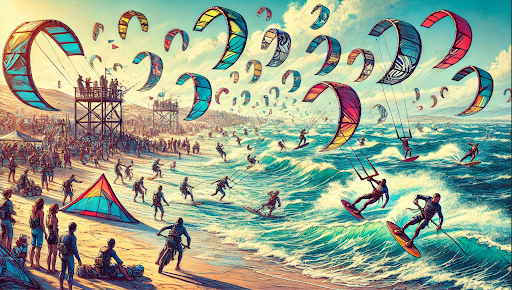Kitesurfing as a Competitive Sport: What You Need to Know

Kitesurfing has evolved from a thrilling recreational activity into a competitive sport with a growing global following. Whether youf’re a seasoned rider looking to enter competitions or simply curious about the competitive side of kitesurfing, understanding the different disciplines, rules, and strategies can help you navigate this exciting world. Here’s what you need to know about kitesurfing as a competitive sport.
- The Different Disciplines of Competitive Kitesurfing
Competitive kitesurfing encompasses several disciplines, each requiring a unique set of skills and offering different challenges. Understanding these disciplines can help you decide which area of competition best suits your interests and abilities.
- Freestyle: Freestyle kitesurfing is one of the most popular competitive disciplines, where riders perform tricks and aerial maneuvers to impress judges. Competitors are scored on the difficulty, execution, and creativity of their tricks, as well as their overall style and flow. Freestyle competitions often feature high jumps, spins, flips, and grabs.
- Big Air: As the name suggests, Big Air competitions focus on achieving the highest and most impressive jumps. Riders are judged based on the height of their jumps, the complexity of the tricks performed in the air, and the landing. Big Air competitions are particularly exciting for spectators, as they showcase the extreme side of kitesurfing.
- Wave Riding: In wave riding competitions, kitesurfers use their kite to ride and carve waves, similar to traditional surfing. Competitors are judged on their ability to perform maneuvers on the wave, their speed, and the overall fluidity of their ride. Wave riding requires strong kite control and an excellent understanding of wave dynamics.
- Racing: Kitesurfing races, also known as kiteboarding races, involve riders competing to complete a course in the shortest time possible. Courses can be set up in various formats, including slalom, long-distance, and upwind/downwind races. Racing emphasizes speed, strategy, and precise kite handling.
- Foil Racing: A variation of traditional racing, foil racing involves the use of hydrofoil boards, which lift the rider above the water and reduce drag. Foil racing is known for its high speeds and requires advanced skills in both kite control and hydrofoil navigation.
- Tip: If you’re interested in getting into competitive kitesurfing, consider training with professionals at Kite Academy El Gouna, where you can hone your skills in various disciplines and prepare for competition.
- Preparing for Competitions
Competing in kitesurfing requires more than just riding skills; it also involves mental preparation, physical conditioning, and a deep understanding of the competition format.
- Training: Regular practice is essential for success in competitive kitesurfing. Focus on building strength, endurance, and flexibility, as well as refining your technique in your chosen discipline. Consider working with a coach who can provide personalized guidance and help you develop a competition strategy.
- Understanding the Rules: Each kitesurfing discipline has its own set of rules and scoring criteria. It’s important to familiarize yourself with these rules before entering a competition. Understanding how judges score different maneuvers, what constitutes a penalty, and how to maximize your points can give you a competitive edge.
- Mental Preparation: Competitive kitesurfing requires mental toughness and the ability to stay focused under pressure. Visualization techniques, meditation, and positive self-talk can help you stay calm and confident during competitions. Remember, the mental aspect of competition is just as important as the physical.
- Tip: For those looking to fine-tune their skills and get ready for competition, Kitesurfing Lessons El Gouna Egypt offers tailored training programs that can help you prepare for the rigors of competitive kitesurfing.
- Competing in Your First Event
Entering your first kitesurfing competition can be both exciting and nerve-wracking. Here are some tips to help you make the most of your debut.
- Choose the Right Event: Start by selecting a competition that matches your skill level and preferred discipline. Many events offer amateur or beginner divisions, which are great for gaining experience without the pressure of competing against seasoned pros.
- Arrive Early: Arrive at the competition venue early to familiarize yourself with the location, wind conditions, and course layout. This extra time allows you to mentally prepare and make any necessary adjustments to your equipment.
- Stay Calm and Focused: It’s natural to feel nervous before a competition, but try to stay calm and focused on your performance. Trust in your training and remember that every competitor started where you are now.
- Observe Other Competitors: Watching other competitors can provide valuable insights into their strategies and techniques. Pay attention to how they handle the conditions and how they interact with the judges.
- Have Fun: While winning is always a goal, remember that kitesurfing is about having fun and enjoying the experience. Embrace the opportunity to learn, connect with other kitesurfers, and celebrate your progress, regardless of the outcome.
- Staying Safe in Competitive Kitesurfing
Safety is paramount in any sport, and kitesurfing is no exception. Competitive kitesurfing often involves pushing your limits, so it’s essential to prioritize safety at all times.
- Use the Right Equipment: Make sure your gear is in top condition before entering a competition. This includes checking your kite, lines, harness, and safety systems. Using equipment that’s suited to the conditions and your discipline is crucial for both performance and safety.
- Know Your Limits: While it’s important to push yourself in competition, it’s equally important to recognize your limits. If conditions become too challenging or you feel fatigued, it’s better to sit out a heat than risk injury.
- Stay Aware of Your Surroundings: Competitive environments can be hectic, with multiple riders on the water at the same time. Stay aware of your surroundings, including other competitors, obstacles, and changing wind conditions.
Conclusion
Kitesurfing as a competitive sport offers a unique blend of excitement, challenge, and camaraderie. Whether you’re drawn to the high-flying action of freestyle, the precision of racing, or the artistry of wave riding, there’s a discipline for every type of rider. With the right preparation, mindset, and safety practices, you can enjoy the thrill of competition and take your kitesurfing skills to new heights.









